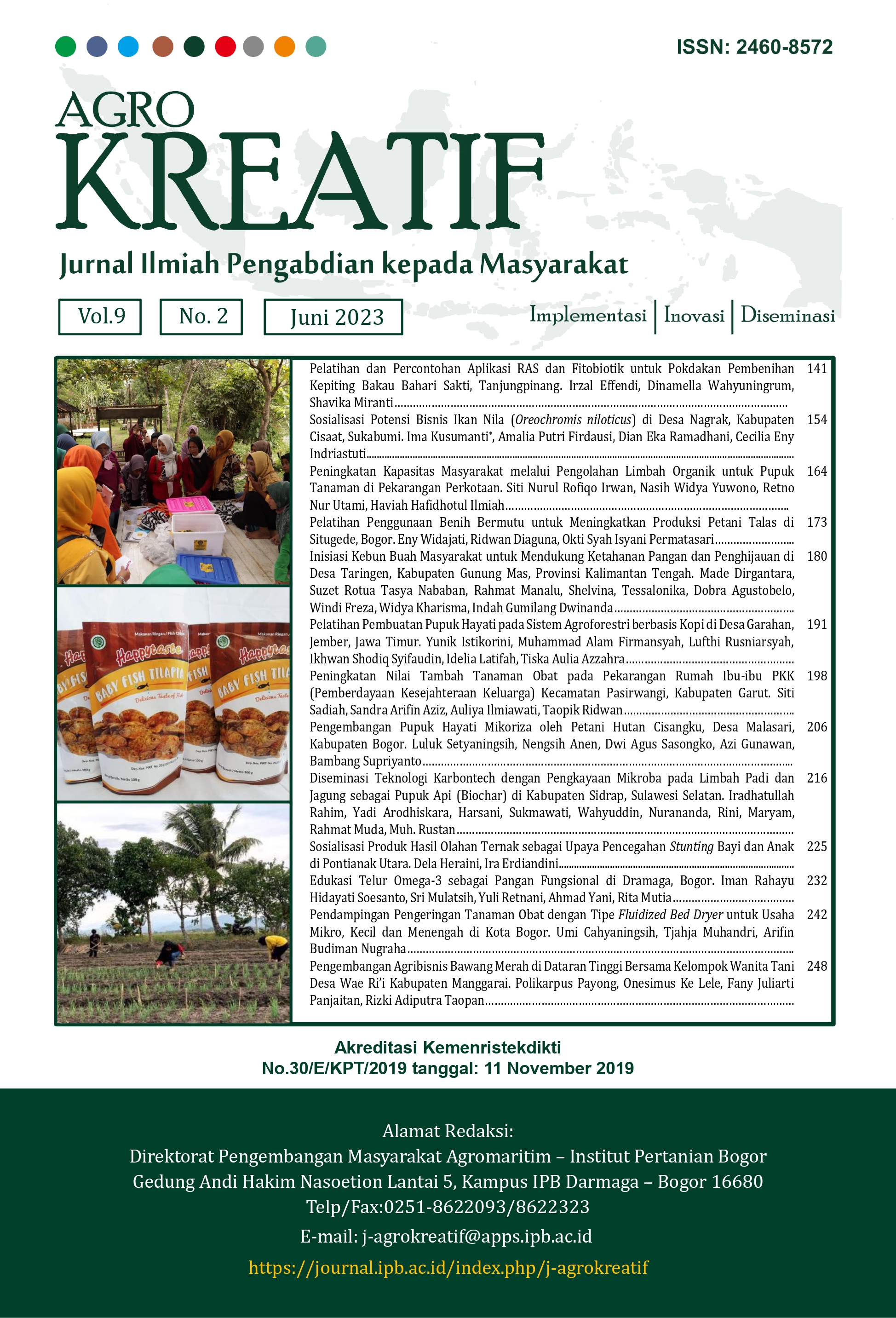Pelatihan Pembuatan Pupuk Hayati pada Sistem Agroforestri berbasis Kopi di Desa Garahan, Jember, Jawa Timur
Abstract
The productivity of coffee plants on the most cultivated land in Garahan Village decreased. This decline is thought to be caused by, among others, climate change, land degradation and the presence of pests and diseases in coffee plants. This training aims to introduce pests and diseases in coffee-based agroforestry to farmers and develop environmentally friendly biofertilizers. This activity begins with a pre-test, socialization and training and ends post-test. Based on the survey and direct observation, coffee plants found upas fungal diseases, root diseases, and stem borer pests. The agroforestry system applied is complex and straightforward agroforestry. In complex agroforestry, coffee plants are grown with various other crops, such as pepper, vanilla, leucaena, taro, banana, gamal, and mahogany. Simple agroforestry consists of coffee land planted with single-shade crops such as leucaena and gamal or a combination of Leucaena and pine. The training results showed an increased farmer's better understanding of coffee pests and diseases, the benefits of agroforestry, and the manufacture of biofertilizers. The biofertilizer developed is expected to increase the productivity of coffee plants.
Downloads
References
Angka WA, Dewi S. 2021. Dampak Perubahan Iklim terhadap Produktivitas Kopi Robusta di Desa Kurrak Kecamatan Tapango Kabupaten Polewali Mandar. Media Agribisnis. 5(2): 133‒139. https://doi.org/10.35326/agribisnis.v5i2.1594
Agustina I, Pinem MI, Zahara F. 2013. Uji efektivitas jamur antagonis Trichoderma sp. dan Gliocladium sp. untuk mengendalikan penyakit lanas (Phytopthora nicotianae) pada tanaman tembakau deli (Nicotiana tabacum L.). Jurnal Online Agroekoteknologi. 1(4): 1130‒1142.
Arifin S, Hartono A, Murtilaksono K, Anwar S, Sunarti dan Kuzyakov Y. 2017. Hubungan karbon organik terlarut dengan sifat tanah pada toposkuen di Taman Nasional Bukit Duabelas. Jurnal Ilmu Tanah dan Lingkungan. 19(2): 51‒59. https://doi.org/10.29244/jitl.19.2.51-59
[BPS] Badan Pusat Statistik. 2023. Kabupaten Jember dalam Angka 2023. Jember (ID): BPS Kabupaten Jember.
Erwanti, Mardius Y, Habazar T, Bachtiar A. 2003. Studi kemampuan isolat-isolat jamur Trichoderma spp. yang beredar di Sumatera Barat untuk mengendalikan jamur patogen Sclerotium roflsii pada bibit cabai. Dalam: Prosiding Kongres Nasional XVI dan Seminar Ilmiah PFI 2003: 22‒24.
George MV, Christopher G. 2020. Structure, diversity, and utilization of plant species in tribal homegardens of Kerala, India. Agroforestry System. 94(1): 297–307. https://doi.org/10.1007/s10457-019-00393-5
Harni R, Samsudin, Amarta W, Indriati G, Soesanthy F, Khaerati, Taufiq E, Hasibuan AM, Hapsari AD. 2018. Teknologi Pengendalian Hama dan Penyakit Tanaman Kopi. Bogor (ID): IAARD Press. 60p.
Khudori. 2006. Teknologi Pemupukan hayati. Jakarta (ID): Republika.
Kusuma YR, Yanti I. 2021. Pengaruh kadar air dalam tanah terhadap kadar c-organik dan keasaman (pH) tanah. Jurnal Penelitian Kimia. 6(2): 92‒97. https://doi.org/10.20885/ijcr.vol6.iss2.art5
Lehar L. 2012. Penguji pupuk organik agen hayati (Trichoderma sp.) terhadap pertumbuhan ketang (Solanum tuberosum L). Jurnal Pertanian Terapan. 12(2): 115‒124.
Neira P, Henríquez-Castillo C, Ortiz J, Stolpe N, Dube F. 2021. Do different densities of tree cover affect pasture biomass and soil microbial communities?. Agroforestry System 95(8): 1465–1478. https://doi.org/10.1007/s10457-021-00653-3
Prasmatiwi FE, Irham A. Suryantini, Jamhari. 2010. Analisis keberlanjutan usahatani kopi di kawasan hutan Kabupaten Lampung Barat dengan pendekatan nilai ekonomi lingkungan. Pelita Perkebunan. 26(1): 65‒75.
Rajput BS, Bhardwaj DR, Pala NA. 2017. Factors influencing biomass and carbon storage potential of different land use systems along an elevational gradient in temperate northwestern Himalaya. Agroforestry System. 91(3): 479–486. https://doi.org/10.1007/s10457-016-9948-5
Supriadi H, Pranowo B. 2015. Prospek pengembangan agroforestri berbasis kopi di Indonesia. Perspektif 14 (2): 135‒150. https://doi.org/10.21082/p.v14n2.2015.135-150
Syakir M, Surmaini E. 2017. Perubahan Iklim Dalam Konteks Sistem Produksi dan Pengembangan Kopi Di Indonesia. Jurnal Litbang Pertanian. 36(2): 77‒90. https://doi.org/10.21082/jp3.v36n2.2017.p77-90
Wilson, Supriadi, Guchi H. 2015. Evaluasi sifat kimia tanah pada lahan kopi di Kabupaten Mandailing Natal. Jurnal Online Agroekoteaknologi. 3(2): 642‒648.
Wiryadiputra S. 2014. Pola Distribusi Hama Penggerek Buah Kopi (Hypothenemus Hampei) pada Kopi Arabika dan Robusta. Pelita Perkebunan. 30(2): 123‒136. https://doi.org/10.22302/iccri.jur.pelitaperkebunan.v30i2.5
Young A. 1990. Agroforestry for Soil Conservation. Wallingford (UK): CAB International
This work is licensed under a Creative Commons Attribution-NonCommercial 4.0 International License.



















